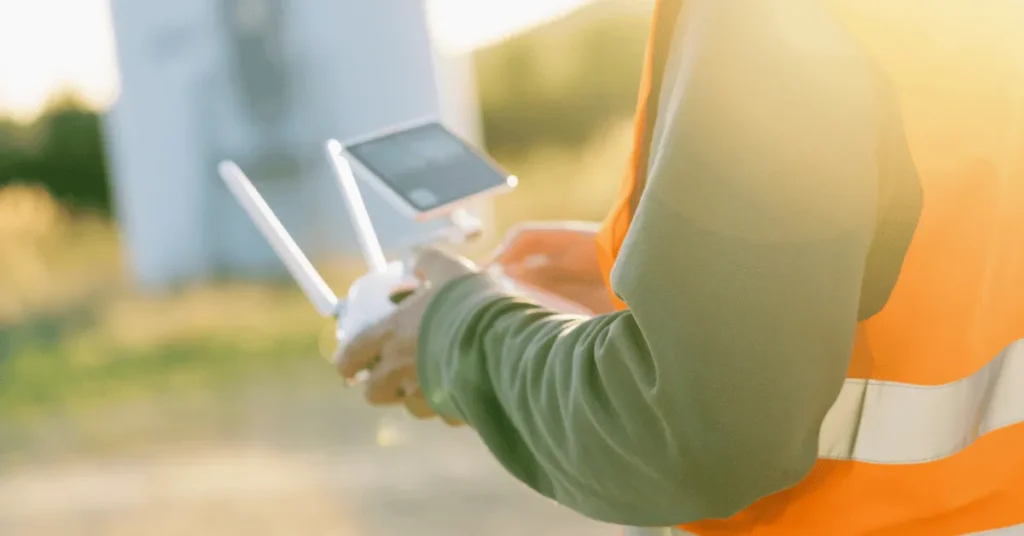Best Entry Level Drone Pilot Jobs in 2023 (A Complete Guide)

The drone industry is growing rapidly, and there is a high demand for entry-level drone pilots. If you are interested in a career in drone piloting, this article will provide you with the information you need to get started.
In this article, I will discuss the requirements for an entry-level drone pilot job, the different types of Entry Level Drone Pilot Jobs, where to find entry-level drone pilot jobs, how much an entry-level drone pilot makes, the benefits of being an entry-level drone pilot, how to get certified as a drone pilot and the best resources for learning about drone piloting.
I will also answer some of the most important FAQs about entry-level drone pilot jobs. By the end of this article, you will have a good understanding of what it takes to become an entry-level drone pilot and how to get started in this exciting field.
Key Takeaways
- To become an entry-level drone pilot, you need to be at least 16 years old, have a good understanding of English, and be physically and mentally fit.
- You also need to pass the FAA’s Remote Pilot Certificate exam.
- There are many different types of entry-level drone pilot jobs, such as real estate photography, inspection, and film production.
- The average hourly wage for an entry-level drone pilot is around $20.92.
- The demand for drone pilots is growing, so there are many opportunities for career advancement.
- Some of the best resources for learning about drone piloting include online courses, webinars, and beginner’s guides.
What are the requirements for an entry level drone pilot jobs?
To kickstart your journey as a novice drone pilot, you’ll need to secure a Remote Pilot certification from the FAA. This certification hinges on successfully passing an aeronautical knowledge exam.
It covers crucial aspects like comprehending the influence of weather, knowing emergency protocols, understanding maintenance procedures, conducting preflight inspections, and grasping aircraft performance intricacies.
Here are the prerequisites: You must be at least 16 years old, possess the ability to read, speak, write, and comprehend English fluently, be in suitable physical and mental shape to ensure safe drone flights, and ace the initial aeronautical knowledge exam dubbed “Unmanned Aircraft General – Small (UAG).”
Gaining a Part 107 Remote Pilot Certificate and garnering hands-on experience in drone operations can open up a world of potentially lucrative prospects for unmanned aircraft operators, or as we commonly refer to them, drone pilots.

It’s worth noting that the criteria for becoming a drone pilot might differ depending on the specific country or region where you intend to fly your drone. Therefore, it’s advisable to consult the pertinent authorities in your area to obtain precise requirements and regulations.
What are the different types of entry-level drone pilot jobs?
In the realm of entry-level drone pilot roles, a multitude of intriguing opportunities await.
These positions revolve around the operation of drones and encompass activities like piloting drones for commercial or private use, mapping landscapes, crafting and refining photographs and videos, and overseeing associated technology.
Here are a few instances of entry-level drone pilot positions:
Commercial Drone/UAS Pilot: This role centers on the utilization of drones for commercial applications, such as inspecting electric generation and utility facilities. While extensive professional drone expertise isn’t mandatory, prior experience in drone operation is certainly an advantage.

Drone Pilot Operations Associate: In this capacity, you’ll provide on-field troubleshooting assistance to drone pilots, coordinate pilot schedules as needed, and evaluate and appraise deliverables to ensure they meet requirements.
Sensor Operator: As a sensor operator, your responsibilities encompass gathering data using sensors affixed to drones. Collaboration with other sensor operators and team members to maintain daily operational status is a vital part of this role.
Remote Pilot Operator: This role involves receiving voice commands from students, entering appropriate inputs into an automated system to simulate pilot actions, and interpreting displayed information to provide fitting responses.
Drone Videographer: If you opt for this path, you’ll be employing a professional drone to capture video footage at a minimum resolution of 4k and a frame rate of 60fps. Reliable transportation to and from shooting locations is essential.

These are merely a handful of examples illustrating the diverse array of entry-level drone pilot opportunities.
For more in-depth insights into these roles, you can explore websites like Indeed.com and ZipRecruiter, which offer comprehensive job descriptions, prerequisites, and application details for a wide spectrum of entry-level drone pilot positions.
Where can I find entry-level drone pilot jobs?
Numerous online platforms offer a wealth of opportunities for discovering entry-level drone pilot positions. Among the most popular are job search websites like Indeed.com and ZipRecruiter.
These user-friendly websites empower you to pinpoint entry-level drone pilot openings based on location, job titles, and various other criteria. Additionally, you have the convenience of uploading your resume and applying directly through these platforms.
Beyond the general job search websites, specialized resources catering to the drone industry can be immensely valuable.
Take, for instance, the Association for Unmanned Vehicle Systems International (AUVSI), which hosts a dedicated job board featuring drone-related roles.
Exploring the websites of drone technology specialists such as DJI or Parrot is another fruitful avenue to uncover potential entry-level drone pilot positions.

In your quest to secure these roles, networking plays a pivotal role.
Attending industry conferences and events, engaging in online forums and groups dedicated to drones, and fostering connections with fellow professionals in the field can yield invaluable insights into job opportunities and help establish meaningful connections.
A diverse array of resources stands ready to assist you in your pursuit of entry-level drone pilot jobs.
By skillfully combining general job search websites, industry-specific platforms, and strategic networking, you can significantly enhance your prospects of landing an exciting entry-level role in the world of drone piloting.
How much does an entry-level drone pilot make?
Based on my research, it appears that the typical hourly wage for an entry-level drone pilot hovers around $20.92.
Nevertheless, the compensation range for entry-level drone pilots can fluctuate based on factors like the industry, location, and specific job prerequisites.
Some sources suggest that entry-level drone pilots might anticipate annual earnings spanning from $30,000 to $45,000, while others propose a foundational salary of $30,000 to $40,000 for those commencing their journey with minimal education and training.

It’s worth emphasizing that as pilots amass experience and refine their skills, their earning potential generally ascends. Proficient drone pilots typically command a higher hourly rate compared to their entry-level counterparts.
Furthermore, particular industries with substantial drone usage, such as the film and television sector, may proffer hourly rates that surpass those found in other domains.
In summation, the remuneration of an entry-level drone pilot can fluctuate contingent on various factors.
Conducting research into the specific prerequisites of the job and the prevailing industry standards in your locale is a prudent step to gain a more precise understanding of the potential earnings awaiting you as you embark on your career as an entry-level drone pilot.
What are the benefits of being an entry-level drone pilot?
Becoming an entry-level drone pilot brings forth a plethora of advantages. One of the primary perks is the chance to immerse yourself in a swiftly expanding and exhilarating field.
Drones have found their place across a diverse spectrum of industries, spanning journalism, public safety, videography, construction, agriculture, military, real estate, education, transportation, and beyond.
As an entry-level drone pilot, you’re poised to garner hands-on experience and hone your skills within the vibrant landscape of these industries.

Yet another compelling benefit of embarking on this journey is the potential for career progression. As you accumulate experience and fortify your skills, the prospect of assuming more advanced roles and responsibilities beckons.
Picture yourself commencing as an assistant to a seasoned pilot, and with dedication and proficiency, advancing to the helm as a lead pilot or even a manager.
In addition to the promising career trajectory, the financial rewards of being an entry-level drone pilot are noteworthy. According to my research, the average hourly compensation for an entry-level drone pilot approximates $20.92.
Furthermore, as you ascend the ranks and ascend the career ladder, your earning potential is poised to ascend in tandem.

To sum it up, venturing into the world of entry-level drone piloting has a multitude of benefits. These encompass the opportunity to thrive in a burgeoning domain, the potential for career elevation, and the promise of financial gains.
What are the challenges of being an entry-level drone pilot?
Becoming an entry-level drone pilot can pose some formidable challenges. One of the initial hurdles involves securing a Part 107 Remote Pilot Certificate, a prerequisite mandated by the FAA for those venturing into commercial drone piloting.
This necessitates passing a rigorous examination, showcasing your grasp of airspace regulations, and demonstrating competence in drone operations.
Another uphill battle is amassing hands-on experience in piloting drones. Various industries, ranging from law enforcement and real estate to filmmaking, journalism, mining, agriculture, and gas and electric utilities, are increasingly integrating drones into their operations.
Consequently, honing your drone-flying skills can unlock numerous opportunities. However, for novice pilots, accruing this valuable experience can be a daunting task.

On top of these trials, entry-level drone pilots must also master the art of inspecting and troubleshooting drone equipment, deciphering intricate weather forecasts, and diligently maintaining flight logs.
Furthermore, effective communication with property or business owners regarding drone operations in the vicinity is paramount. Cultivating proficiency in all these areas is a process that demands time and relentless practice.
In sum, the journey to becoming an entry-level drone pilot demands a substantial investment of both time and effort. Yet, the dividends can be substantial.
Drone pilots are currently in high demand across various industries and can command a lucrative income. The average hourly wage for entry-level drone pilots stands at an impressive $41.21 per hour.
How can I get certified as a drone pilot?
If you’re looking to dive into the world of commercial drone operations, you’ll need to secure a Remote Pilot Certificate from the Federal Aviation Administration (FAA). This certificate is your ticket to demonstrating your grasp of the rules, operational requirements, and safe practices for piloting drones.
To embark on this exciting journey, you must meet a few prerequisites. Firstly, you should be at least 16 years old, and you should have a firm command of reading, speaking, writing, and comprehending English.
Additionally, maintaining good physical and mental health is crucial to ensure your ability to pilot drones safely.

Beyond that, there’s the essential step of passing the initial aeronautical knowledge exam, known as “Unmanned Aircraft General – Small (UAG).”
Now, let’s break down the steps that will lead you to becoming a certified drone pilot:
- Acquire an FAA Tracking Number (FTN): Your journey begins by obtaining an FAA Tracking Number (FTN). This involves creating an Integrated Airman Certification and Rating Application (IACRA) profile before you can register for the knowledge test.
- Schedule the Knowledge Test: Next up, you’ll want to schedule an appointment with an FAA-approved Knowledge Testing Center. Remember to bring a valid government-issued photo ID on the day of your test.
- Pass the UAG Knowledge Test: Successfully navigate and conquer the initial aeronautical knowledge test, which is none other than the “Unmanned Aircraft General – Small (UAG)” examination.
- Complete FAA Form 8710-13: After taking the exam, you’ll be required to complete FAA Form 8710-13 to obtain your remote pilot certificate. The magic happens through the electronic FAA Integrated Airman Certificate and/or Rating Application System (IACRA).
- TSA Security Background Check: Await the much-anticipated confirmation email, signaling the successful completion of your TSA security background check. This email will contain detailed instructions for printing a temporary copy of your remote pilot certificate from IACRA.
- Receiving Your Permanent Certificate: Lastly, keep an eye on your mailbox for the arrival of your permanent remote pilot certificate. This will make its way to you once all other FAA-internal processing is wrapped up.

In a nutshell, the journey to becoming a certified drone pilot revolves around acing the FAA Part 107 test and showcasing your deep understanding of airspace regulations and drone operations.
With this certification in your arsenal, you’ll gain the authority to engage in commercial drone flights and explore the vast array of opportunities that await in this thrilling field. Get ready to take to the skies!
What are the best resources for learning about drone piloting?
When it comes to learning the ropes of drone piloting, you’ve got a variety of resources at your fingertips.
Online Courses:
If you’re keen on mastering drone piloting, online courses are a top-notch choice. You can’t go wrong with options like the Ultimate Drone Pilot Guide from the Pilot Institute or the AOPA Drone Pilot Resources courtesy of the Aircraft Owners and Pilots Association.
These courses cover the whole shebang of drone piloting, from safety protocols to the nitty-gritty of regulations and best practices.
Webinars:
Are you looking for another ace resource? Check out webinars. The AOPA Air Safety Institute puts out webinars that delve deep into drone safety.

They tackle real-world challenges, the sweet and sour of drone flying, and even the dreaded drone battery dilemma. These webinars serve up priceless insights into the world of drone piloting.
Beginner’s Guides:
If you’re just starting your drone journey, beginner’s guides are your go-to. TechRadar has a beginner’s guide that dishes out 9 essential tips for safe and skillful piloting.
It’s your roadmap through the legalities, planning stages, pilot techniques, and more, giving beginners the lift they need to get started.
No matter your learning style, be it online courses, webinars, or beginner’s guides, there’s something tailor-made for you. Armed with these resources and a hefty dose of practice, you’ll be soaring high as a skilled drone pilot in no time.

Important FAQs
What is the first step to becoming an entry-level drone pilot?
Are there age requirements to become a drone pilot?
Do I need to be fluent in English to become a drone pilot?
Can I become a drone pilot if I have physical limitations?
Where can I find entry-level drone pilot job opportunities?
What is the average hourly wage for entry-level drone pilots in 2023?
Are there opportunities for career advancement in drone piloting?
What resources are available for learning about drone piloting?
Final Thoughts
As we find ourselves in the year 2023, the drone industry is in the midst of rapid expansion, resulting in soaring demand for entry-level drone pilots. Should you decide to embark on this exhilarating journey, there are specific prerequisites to meet.
These include securing a Remote Pilot certification from the FAA, a pivotal step that entails acing an aeronautical knowledge exam. This certification is your key to possessing the requisite skills and knowledge for the safe operation of drones.
The world of entry-level drone pilot roles is incredibly diverse, offering a plethora of opportunities. From engaging in commercial drone piloting to delving into sensor operation and the art of drone videography, the choices are abundant.
To navigate this landscape effectively, job search platforms like Indeed.com and ZipRecruiter prove to be invaluable resources. Furthermore, specialized industry platforms and networking can further amplify your prospects in this field.
In terms of remuneration, entry-level drone pilots can anticipate an average hourly wage hovering around $20.92, with the potential for higher earnings as experience accrues.
Beyond monetary rewards, this career path immerses you in a rapidly burgeoning field. It presents opportunities for career advancement and promises financial gains.
Nonetheless, the path to becoming an entry-level drone pilot isn’t without its challenges.
Acquiring the essential certification and accumulating hands-on experience can be demanding, but the potential rewards are well worth the effort. The demand for skilled drone pilots is on the rise, offering a promising career trajectory.
To obtain certification as a drone pilot, a series of steps must be followed, including the successful completion of the FAA Part 107 knowledge test. Fortunately, a plethora of resources are available to aid in your journey, ranging from online courses and webinars to beginner’s guides.
Read More:
- What SD Card Do I Need for DJI Inspire 2?
- Is It Worth Buying a Drone? | 14 Benefits and 5 Drawbacks of Drones.
- How to Make Money With a Drone? (17 Best Ways)
- Waterproof Fishing Drone || A proper buying guide for a fishing drone.
All images are taken from Canva.com
Does DJI Mini 3 Pro Have Follow Me? | Obstacle Avoidance Features
Eager to know if DJI Mini 3 Pro has “Follow Me” and obstacle avoidance? 🚁🛡️ Dive into this article to uncover all the exciting details! Don’t miss out on the next-level drone features. 📸✨







